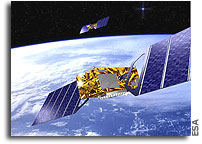Galileo duo handed over in excellent shape

A pair of fully functioning Galileo navigation satellites was recently delivered to its operators, as preparations get underway for the next round of launches.
On 27–28 September, the two satellites launched on 22 August were handed over from ESA’s Space Operations Centre, ESOC, in Darmstadt, Germany, to the Galileo Control Centre, Oberpfaffenhofen, which will care for them pending a final decision on their use.
The satellites are in excellent health and working normally.
A launcher problem left the pair in the wrong orbit, with higher apogee, lower perigee and an incorrect inclination compared to the planned circular orbit.
Training for challenges
The orbit presented a sudden and unexpected – though not untrained for – challenge to the team at ESOC responsible for the launch and early orbit phase.
For months before each Galileo launch, a joint team of mission operations experts from ESA and France’s CNES space agency train intensively for this critical period, which typically lasts about eight days, from separation until handover to Oberpfaffenhofen.
“After launch, we quickly discovered that one of each satellite’s pair of solar wings had not deployed correctly,” says Liviu Stefanov, Spacecraft Operations Manager.
“At the same time, difficulties in receiving radio signals – indicated by unusually low power and instability – alerted us to the fact that the orbits could be incorrect.
“Basically, the ground stations were pointing to where we expected the satellites to be, and they weren’t there, so we weren’t getting good signals.”
Quick teamwork to find satellites
Engineers determined within four hours the approximate actual orbit and then generated new commands to point the ground antennas to establish robust radio links.
Working around the clock, and with assistance from the Galileo project engineers and the satellite builder, the teams then started to look at how to free the solar arrays.
“Each undeployed wing had to be treated as a separate problem,” says Flight Operations Director Hervé Côme.
“Each satellite had to be manoeuvred separately into an orientation where the undeployed panel was facing the Sun because we realised that one cause was linked to the low temperature of the release mechanism.
“It all required developing, validating and rehearsing new flight operation procedures ‘on the fly’.”
It took three days to release the trapped solar wing of the first satellite, and then two days later the second Galileo’s stuck array was also freed.
The satellites have since been brought into full operation, as the teams in Darmstadt were tasked to retain control for five weeks – four weeks longer than planned.









